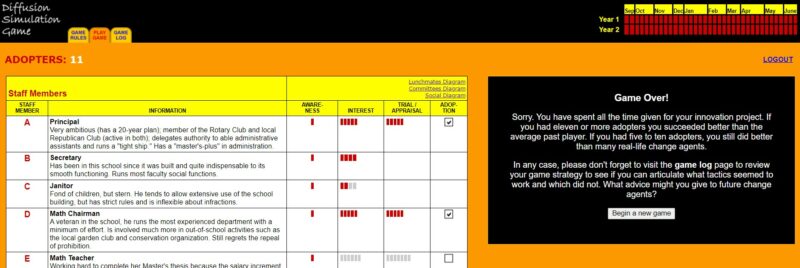This week I was asked to write a blog post about one of my most memorable experiences with congruence in education and think about my experiences as a learner, as opposed to a teacher.
One of the most positive learner experiences I can recall was in the Children’s Literature course I took during my undergraduate degree at SFU with Dr. Nicky Didicher. The day she showed up to lecture in full traditional and homemade Victorian garb (down to the undergarments!), I knew that this was going to be an awesome class. I remember her syllabus at the beginning of the term clearly outlined the layout of the course, the chosen text was a useful and enjoyable read, and her assessment practice was unlike anything I had experience at the college level.
At the beginning of the term, students were given the list of summative assessments they were to expect throughout the course with varying weights beside them. With some limitations in place, students decided what weight they would like each assignment to be for their final grade. If you were a strong oral learner, you could weigh the presentation heavier. If you found you were able to showcase your learning best through writing, you would weigh the final paper heavier. Each student all had to complete the same summative assessments, but their weights fit the preferred styles of showing their learning. It blew my mind.
I still use this inspiration in my own classrooms today, giving choice in summative assessment whenever possible. Nicky, if you ever stumble onto this blog post – thank you.
Upon reflection (an because the prompt this week has asked to explore a weakness), the one area I felt that perhaps could have made this class more congruent, as was the case with many of my university classes, was providing more information about the summative marking criteria. Often times, professors will provide a letter grade at the top of a paper with a few comments, but rarely would I see a specific criteria for where their determinations come from. I always found this frustrating, so I make it a point of dedicating class time to review my rubric criteria with students, provide time to ask questions, and opportunity for students to provide self-assessment prior to my marking.
One other area of incongruence that I found frustrating as a student was the (often unnecessary) disappointment I felt when I didn’t receive an “A.” (In hindsight now, they seems so unimportant now.) In response, one area that I’m starting to explore is Shelley Moore’s learning maps for creating meaningful rubrics. As opposed to an letter grade focus, her rubrics work backwards starting at the point of accessibility to which “all” students will meet by the end of the lesson and spans with increasingly more challenging levels of understand that students can choose to meet. That way, I find that students as less focused on being disappointed by a “B” and rather eager to push their learning to as high a level they feel comfortable while taking pride in how far they have come.
Image credit: https://pixabay.com/photos/books-literature-read-worn-paper-3482286/






3 Comments
Add Yours →Thanks Anna! What a really cool idea! I’ve only experienced student choice in the choosing of an actual assignment format (oral, written, etc.). To allow students to give weight to each assignment based on their perceived strengths is an excellent idea.
I feel the same way about feedback regarding rubrics and letter grades. I have found that most of my post secondary courses lack in specific feedback regarding where I have lost marks. I make a point in my own classroom grading to include ‘moving forward’ feedback, so students have a clear understanding of what they need to focus on to progress.
Corey
Hi Anna, great post!
What a wonderful learning experience for you and your peers. It is not lost on me how impactful it is when someone goes above and beyond their regular duties. The proof is in your vivid memory of the day your prof showed up in full Victorian garb. When introducing a new concept, I will often try to do something silly. I have found that this helps my students remember the formula or concept later on. For instance, before a lesson introducing cross multiplication, students would arrive to class with me wearing a big sombrero hat. Without telling them why I was wearing it, I would begin my fractions lesson. After going through the process I stood back and asked them what the ovals surrounding the numbers on the board looked like and they realized it was a sombrero. The method became known as the Sombrero Method and I have had students many years later tell me they still remember it.
There are some other fantastic things that your prof did, including her enjoyable selection of texts. Being an English major as well, I have certainly read my share of dreadfully boring texts. It doesn’t have to be this way. In all periods of English Literature, there are a plethora of interesting options. Besides this fact, being passionate about what you are teaching can make up for a less-than-inspiring selection.
What stands out most, however, is her assessment practice. Giving students options on how they would like to be assessed is awesome. How sad this is the first I have heard of it at the post-secondary level, when it is an increasingly common practice amongst grade school teachers.
Including a rubric during the introduction of an assignment is an important step in the process that many teachers forget. They are crucial in ensuring students know exactly what the expectations and learning goals are for an assignment. I also like to share sample papers or projects with my students for further clarification and to help them generate some ideas. When showing samples, I don’t tell the students what grade each paper received; I get them to come up with what they think each paper received and reasons why. By analyzing the samples, it gives the students a better idea of what I am looking for and they are able to pinpoint what some papers do well and where other papers are lacking. This also helps to eliminate the inevitable questions like “How long does this have to be?” and “Is this good enough?”
I’m so glad that you referenced Shelley Moore. She is brilliant and her work should be well-known to every teacher. Her rubrics are amazing and her efforts and lesson planning ideas to include everyone are inspiring. A very enjoyable read, Anna, thank you!
Aaron
Interesting post Anna! I’ve heard of instructors allowing students to chose their own weighting on assignments and have always been curious to try it. Giving students that empowerment at the beginning of the semester would surely add to their motivation to succeed. The course you described sounds great!